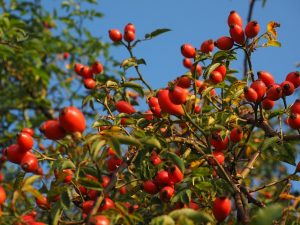(Rosa canine)
Rose-hips are the oval shaped hips of the wild dog rose , and are often seen growing in hedgerows.
 What do Rose-hips look like?
What do Rose-hips look like?
Rose-hips have long stems and flowers that are usually pale pink in colour with yellow stamens. After flowering a green rose-hip is produced that ripens to red.
You often see rose-hips in the hedgerows during late summer, autumn and early winter.
 It is said that rose-hips taste sweeter after the first frost, yet if you can’t wait that long, they still have a delicious sweetness.
It is said that rose-hips taste sweeter after the first frost, yet if you can’t wait that long, they still have a delicious sweetness.
Picking rose-hips can cause some skin irritation due to tiny hairs on the seeds, so wear gloves when picking them.
How to prepare Rose-hips
Rose-hips can be used fresh, or dried to keep a long-lasting store to see you through to the next season. The seeds should be removed to avoid any possible irritation.
To remove seeds from dried rose-hips, you can put them in a food processor and grind them up. Then, place a sieve over a bowl and add some of the dried mixture. Shake the sieve, and all of the irritating hairs will fall through, and you are left with dried rose-hip that is ready to use.
If using fresh rose-hips, slice them lengthways and scrape out the seeds before cooking.
There are lots of things to make with rose-hips, including a sweet syrup, jams, jellies, tea and wine.
Health benefits of Rose-hips
Rose-hips are full of antioxidants and have more vitamin C than citrus fruits. Because of their impressive vitamin C content, rose-hips were collected and made into a syrup to help keep the nation healthy during the Second World War.
The nutritious rose-hip has also been used as a treatment for stomach ulcers, diarrhoea and cholesterol problems.
Although they might be a bit fiddly to prepare, the nutritional benefits and complex, sweet taste of the rose-hip makes it more than worthwhile.
Do you forage for rose-hips? Share your recipes!
Back to list of wild edible foods





